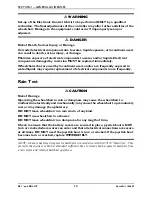
SECTION 4—SAFETY/HANDLING OF WHEELCHAIRS
R51™and R51LXP
24
Part No. 1106645
6. The wheelchair should not be lowered until the last stair has been negotiated and the
wheelchair has been carried away from the stairway.
Escalators
WARNING
DO NOT use an escalator to move a wheelchair between floors. Serious bodily
injury may occur.
Transferring To and From Other Seats
WARNING
Risk of Serious Injury or Damage
Improper transfer techniques may cause serious injury or damage.
Before attempting transfers, consult a health care professional to determine proper
transfer techniques for the user and type of wheelchair.
Reduce gap between transfer surface and wheelchair
seat to the minimum distance necessary to perform transfer.
Align casters parallel to the drive wheels to improve stability during transfer.
ALWAYS turn the wheelchair power off.
ALWAYS engage both motor locks/clutches and free wheel hubs (if equipped) to
prevent the wheels from moving before transferring into or from the wheelchair.
CAUTION
When transferring, position yourself as far back as possible in the seat. This will prevent
broken screws, damaged upholstery and the possibility of the wheelchair tipping forward.
NOTE: For this procedure, refer to FIGURE 4.1.
NOTE: This activity may be performed
independently provided you have adequate
mobility and upper body strength.
1. Position the wheelchair as close as
possible along side the seat to which
you are transferring, with the casters
pointing parallel to it.
2. Engage clutches. Refer to
Engaging/Disengaging the Clutches on
page 71.
3. Shift body weight into seat with
transfer.
During independent transfer, little or no
seat platform will be beneath you. Use a
transfer board if at all possible.
FIGURE 4.1
Transferring To and From
Other Seats
MINIMUM GAP
DISTANCE















































